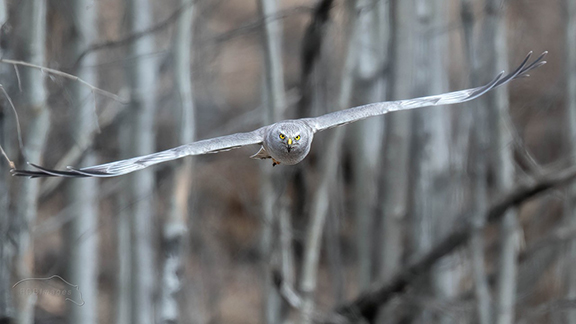An international team of University of Lethbridge and Flinders University (Australia) researchers made the discovery when they found unexpectedly owl-like traits in the ear and brain of several harrier species, such as the Australian spotted harrier. Their study, The evolution of an "owl-like" auditory system in harriers: Anatomical evidence, is now available online in Journal of Anatomy.

A northern harrier seeks prey while flying over a field. PHOTO by Bob Bowhay, rdbimages.ca
"Owls have fine-tuned hearing abilities, allowing some species to locate prey in complete darkness. Until recently, it was assumed that all their hearing adaptations were unique to owls. However, our study shows that that harriers have independently evolved several key adaptations for finding prey by sound," says Sara Citron, a ULethbridge PhD student who led the study.
Citron's supervisor, Dr. Andrew Iwaniuk, says the team focused on harriers a group of hawks found in North America, Australia, NZ, Europe, and parts of Africa and Asia because they show some unusual, owl-like hunting behaviours.
"Hawks tend to hunt primarily by sight. But unlike other hawks, harriers fly low over tall grass with their beak pointed to the ground. During this so-called "quartering flight", they are not only looking for prey, they are also listening for it," says Iwaniuk.
Co-author Aubrey Keirnan, a PhD student at Flinders University who is co-supervised by Iwaniuk, says that simply by looking at the harrier, you can see similarities with owls.
"The Australian Spotted Harrier is a great example," she says. "When you look at this species' face, you can see a distinctive disc-shaped face, which may improve their prey localization just like owls."
Citron adds that their find also matches older behavioural studies showing that harriers can locate sounds with similar accuracy to owls, but how they did this has previously remained a mystery.
Using specimens from wildlife rehabilitators and museums in Australia and Canada, the team examined the anatomy of the skull and brain of harriers and other, closely related hawk species such as the wedge-tailed eagle. They found that, like owls, harriers have enlarged ear openings and expanded two brain regions that are essential for calculating where a sound is coming from.
"These auditory nuclei are found in the brainstem and compare the time at which sounds arrive at the left or right ear. If a sound arrives at both ears at the same time, then the sound is coming from directly in front of an animal. If there is a delay, this indicates that the prey is more to the left or right," says co-author Dr. Vera Weisbecker, an associate professor in evolutionary biology at Flinders University. "By expanding these two brain regions, harriers can make such computations more accurately than other hawks, allowing them to locate where a potential rat, mouse or other rodent is hiding in the grass."
"Harriers have therefore evolved an auditory system similar to owls, enabling them to target sounds as accurately as owls in a remarkable example of convergent evolution of both brain and behaviour in animals separated by over 60 million years," adds Citron.
The team is careful to point out that the auditory system of many owls is far more sophisticated than that of harriers. This explains the ability of some owl species like the barn owl to hunt in complete darkness whereas hawks only hunt during the day.
"There are several other features that help owls with their keen hearing which we did not find in harriers," says Citron. "For example, some owl species have asymmetric ears that allow them to locate sound with greater acuity, and these owls also have several other enlarged brain regions that were not enlarged in harriers."
The team hopes their study results will encourage further research on bird anatomy to find out how a species perceives its surrounds.
"Anatomical studies like ours are a window into how a bird perceives the world around it, which can be extremely useful for bird conservation," says Iwaniuk. "For example, harriers' reliance on sound for prey location means that they are likely more sensitive to traffic and industrial noise. This could be contributing to the large decreases in Northern Harrier populations we have seen in Canada."













